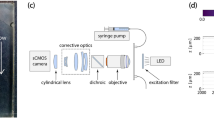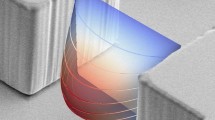Abstract
We present two methods how the permeability in porous microstructures can be experimentally obtained from particle tracking velocimetry of finite-sized colloidal particles suspended in a liquid. The first method employs additional unpatterned reference channels where the liquid flow can be calculated theoretically and a relationship between the velocity of the particles and the liquid is obtained. The second method takes advantage of a time-dependent pressure drop that leads to an exponential decrease in the particle velocity inside a porous structure. From the corresponding decay time, the permeability can be calculated independently of the particle size. Both methods lead to results comparable with permeabilities derived from numerical simulations.






Similar content being viewed by others
References
Auset M, Keller AA (2004) Pore-scale processes that control dispersion of colloids in saturated porous media. Water Resour Res 40(3):W03,503
Auset M, Keller AA (2006) Pore-scale visualization of colloid straining and filtration in saturated porous media using micromodels. Water Resour Res 42(12):W12S02
Bruus H (2007) Theoretical microfluidics. Oxford University Press, Oxford
Carman PC (1937) Fluid flow through granular beds. Trans Inst Chem Eng 15:150–166
Frenkel D (2002) Soft condensed matter. Phys A Stat Mech Appl 313(1–2):1–31. doi:10.1016/S0378-4371(02)01032-4
Katz AJ, Thompson AH (1986) Quantitative prediction of permeability in porous rock. Phys Rev B 34:8179–8181. doi:10.1103/PhysRevB.34.8179
Kozeny J (1927) Uber kapillare leitung des wassers im boden. Sitzber Akad Wiss Wien, Math-naturw 136:Abt. II a, p 277
Lindken R, Rossi M, Große S, Westerweel J (2009) Micro-particle image velocimetry ([small micro]piv): recent developments, applications, and guidelines. Lab Chip 9:2551–2567. doi:10.1039/B906558J
Loutherback K, Puchalla J, Austin RH, Sturm JC (2009) Deterministic microfluidic ratchet. Phys Rev Lett 102(4):045,301. doi:10.1103/PhysRevLett.102.045301
Marshall T, Holmes J, Rose C (1996) Soil physics. Cambridge University Press, Cambridge
Ouellette NT, O’Malley PJJ, Gollub JP (2008) Transport of finite-sized particles in chaotic flow. Phys Rev Lett 101(17):174,504. doi:10.1103/PhysRevLett.101.174504
Quake SR, Scherer A (2000) From micro-to-nanofabrication with soft materials. Science 290(5496):1536–1540. doi:10.1126/science.290.5496.1536
Sahimi M (1993) Flow phenomena in rocks: from continuum models to fractals, percolation, cellular automata, and simulated annealing. Rev Mod Phys 65(4):1393–1534. doi:10.1103/RevModPhys.65.1393
Santiago JG, Wereley ST, Meinhart CD, Beebe DJ, Adrian RJ (1998) A particle image velocimetry system for microfluidics. Exp Fluids 25:316–319. doi:10.1007/s003480050235
Segre G, Silberberg A (1962) Behaviour of macroscopic rigid spheres in poiseuille flow part 2. Experimental results and interpretation. J Fluid Mech 14(01):136–157. doi:10.1017/S0022112062001111
Staben M, Zinchenko A, Davis R (2003) Motion of a particle between two parallel plane walls in low-reynolds-number poiseuille flow. Phys Fluids 15:1711–1711
Taylor G (1953) Dispersion of soluble matter in solvent flowing slowly through a tube. Proc Royal Soc Lond Ser Math Phys Sci 219(1137):186–203. doi:10.1098/rspa.1953.0139
Pushkin DO, Melnikov DE, Shevtsova VM (2011) Ordering of small particles in one-dimensional coherent structures by time-periodic flows. Phys Rev Lett 106(23):234501-1–234501-4
Acknowledgments
We would like to thank Valentin Blickle, Hans-Jürgen Kümmerer and Gerd E. Schröder-Turk for inspiring discussions.
Author information
Authors and Affiliations
Corresponding authors
Additional information
Christian Scholz and Frank Wirner contributed equally to this publication.
Appendices
Appendix 1: Theoretical calculation of mean particle velocity
First we assume that gravity leads to a non-uniform particle distribution described by the Boltzmann distribution
where λ is the gravitational length.
Second we use numerical values from (Staben et al. 2003) to describe the local particle velocity u d (z). Third we consider the biased sampling, as the inception rate of the particles (coming from an infinite reservoir) is proportional to the particle speed, which results in an effective particle distribution
Combining these assumptions, the mean particle velocity is given by
Appendix 2: Exponential decrease in mean particle velocity
First we use that \(\Updelta P=\rho g \Updelta h\) and the excess volume is given by \(V=A_{{\rm res}}\Updelta h\) which yields
Second we know the time derivative of the excess volume is related to the total flux, so that
where the factor 2 is due to the relative increase and decrease in the water column in the two reservoirs. Now we insert Eq. 7 and Darcy’s law into Eq. 8, which gives
Using \(\Updelta P \propto \bar{u}\) we arrive at
where τ = ηL A res/(2Aρg k).
Rights and permissions
About this article
Cite this article
Scholz, C., Wirner, F., Li, Y. et al. Measurement of permeability of microfluidic porous media with finite-sized colloidal tracers. Exp Fluids 53, 1327–1333 (2012). https://doi.org/10.1007/s00348-012-1362-9
Received:
Revised:
Accepted:
Published:
Issue Date:
DOI: https://doi.org/10.1007/s00348-012-1362-9




